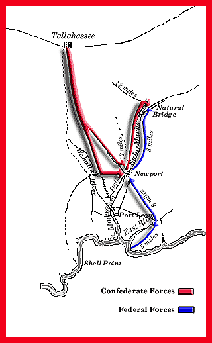The Battle of Natural Bridge
confederate drummer
 Late in the war, in March 1865, a combined Union army and naval force assembled in the
northern Gulf of Mexico off St. Mark's. Almost 1,000 Union troops, including several
hundred Florida soldiers in the 2nd Florida Union Cavalry, landed near the St. Mark's
lighthouse and prepared to move inland. The initial targets of the expedition appear to
have been the town and fort of St. Mark's. However, with a large Union force moving
inland, the Confederates thought that there was a clear danger to the capital city,
Tallahassee.
Late in the war, in March 1865, a combined Union army and naval force assembled in the
northern Gulf of Mexico off St. Mark's. Almost 1,000 Union troops, including several
hundred Florida soldiers in the 2nd Florida Union Cavalry, landed near the St. Mark's
lighthouse and prepared to move inland. The initial targets of the expedition appear to
have been the town and fort of St. Mark's. However, with a large Union force moving
inland, the Confederates thought that there was a clear danger to the capital city,
Tallahassee. 
Following a skirmish at Newport bridge on the St. Mark's River, the Union commander,
Brigadier General John Newton, decided to conduct a night march north to Natural
Bridge in hopes of crossing the river unopposed. Observant Confederate scouts reported
the move, and the southern field commander, Brigadier General William Miller,
redirected his forces in the area to meet the threat. The southern troops consisted of both
Florida cavalry and artillery soldiers, supplemented with young and old militia members,
and a small group of young cadets from the Florida Military Institute in Tallahassee.
At dawn on March 6, 1865, the sound of gunfire could be heard at the Natural Bridge
crossing. The first attempt by the Union troops to cross quickly was checked by southern
fire. Both sides reinforced their positions during the morning, and the northern troops
searched for another way across the river. Unable to find another crossing point, the
federal commander chose to force a passage at Natural Bridge. Near midday the Union
troops of the 2nd and 99th U.S. Colored Infantry regiments attacked. For several hours
the woods and swamps echoed with the sounds of battle.
The Confederates had the advantages of a solid defensive position, more cannons, and,
by the end of the battle, more troops. After finally realizing that they could not
successfully force their way across Natural Bridge, the Union troops broke off the
engagement and retreated to the safety of the coast. The battle resulted in 148 casualties
for the northern side and 26 casualties for the southern side. The Confederate victory
ensured that Tallahassee would remain in southern hands for the remainder of the
war--the only southern capital east of the Mississippi River with that distinction.

Back to Rebels Rock
 Late in the war, in March 1865, a combined Union army and naval force assembled in the
northern Gulf of Mexico off St. Mark's. Almost 1,000 Union troops, including several
hundred Florida soldiers in the 2nd Florida Union Cavalry, landed near the St. Mark's
lighthouse and prepared to move inland. The initial targets of the expedition appear to
have been the town and fort of St. Mark's. However, with a large Union force moving
inland, the Confederates thought that there was a clear danger to the capital city,
Tallahassee.
Late in the war, in March 1865, a combined Union army and naval force assembled in the
northern Gulf of Mexico off St. Mark's. Almost 1,000 Union troops, including several
hundred Florida soldiers in the 2nd Florida Union Cavalry, landed near the St. Mark's
lighthouse and prepared to move inland. The initial targets of the expedition appear to
have been the town and fort of St. Mark's. However, with a large Union force moving
inland, the Confederates thought that there was a clear danger to the capital city,
Tallahassee. 
